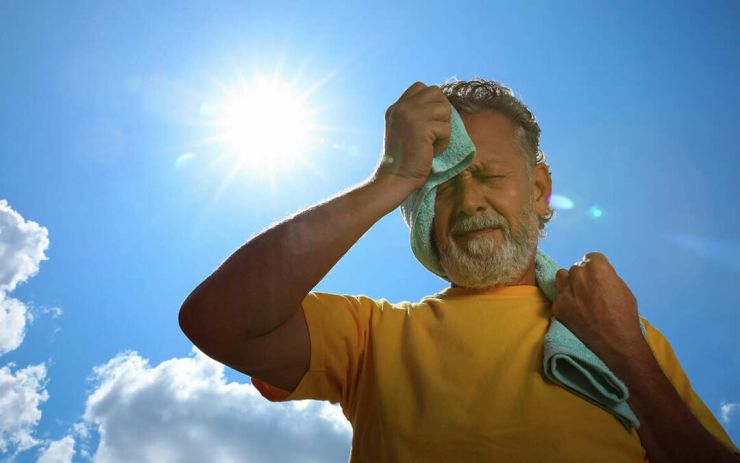
Beat the Heat: Tips for Avoiding Heat Stroke and Heat Exhaustion
Summer fun might be giving way to fall festivities soon. But August still has plenty of exciting outdoor activities for families in Virginia to enjoy. As temperatures stay high, it’s important to stay aware of the risk of heat exhaustion and heat stroke.
Whether you’re soaking up the rays on a local trail or lounging by the waves at your favorite beach, heat-related illnesses can strike quickly. Being aware of the symptoms and knowing what to do for heat exhaustion and heat stroke can be lifesaving. In this article, we’ll teach you everything you need to know to stay prepared throughout the hottest days of summer.
What is Heat Exhaustion?
When you’re outdoors in the heat, your body reacts by producing lots of sweat to keep you cool. If your body stays hot for too long, or you’re participating in vigorous exercise that causes you to lose excess fluids, heat exhaustion can strike. This happens when you’ve lost too much water and salt, making it harder for your body to cool down.
So what does heat exhaustion look like? Symptoms for most people include:
-
Headache
-
Dizziness or lightheadedness
-
Nausea
-
Intense thirst
-
Muscle weakness
-
Elevated body temperature
-
Decreased urine output (peeing less and less often)
Though anyone can experience heat exhaustion, certain groups are more likely to be affected. This includes the elderly, those with high blood pressure, and anyone working or exerting themselves in a hot environment.
What is Heat Stroke?
Even more serious than heat exhaustion, heat stroke occurs when your body is no longer able to regulate your temperature. This causes your temperature to rise to dangerous levels and can be fatal if emergency care is not available.
Symptoms of heat stroke include those of heat exhaustion, as well as more severe signs including:
-
Confusion or decreased mental status (such as slurred speech)
-
Loss of consciousness
-
Seizures
-
Hot, dry skin or extreme sweating
Heat stroke causes your body to shut down as your temperature rises to 106°F or higher. This can happen quickly, in as little as 10-15 minutes. Taking immediate action to cool down and rehydrate is the only way to reverse heat stroke.
However, anyone suffering from these symptoms must be treated by a medical professional due to the risk of severe complications. If you suspect heat stroke, call 911 immediately and move the person to a shaded, cool area as soon as possible. Using cold water, ice, and wet cloths can also help cool the affected person down.
What to Do for Heat Exhaustion?
Although heat exhaustion isn’t life-threatening, it can quickly become dangerous if left untreated. If someone is exhibiting signs of heat exhaustion, take steps to help them cool down and rehydrate immediately.
Find a shady, cool area to rest and take sips of cool water or a sports drink. Removing unnecessary clothing, such as shoes and additional layers, is also helpful. If available, use a damp cloth or cold compress on the head, face, neck, and armpits.
When someone is suffering from heat exhaustion, they should still be seen by a medical professional to ensure they receive the necessary treatment and prevent complications. Urgent care is a great place to turn. Providers are trained to handle heat exhaustion and will perform a thorough assessment to determine the best treatment plan. Urgent care can also provide IV fluids to help rehydrate someone suffering from heat exhaustion.
How to Avoid Heat-Related Illness
The dangers of heat-related illness can’t be underestimated. While heat exhaustion and heat stroke are treatable, it’s best to avoid these conditions entirely. Luckily, there are several easy steps you can take to avoid heat-related illnesses this summer.
Here are a few tips to consider:
-
Drink plenty of fluids: Sweating removes water and essential minerals from your body. Replenish them by drinking more fluids (especially water or a sports drink) whenever you’re outdoors or in the heat.
-
Stay cool: When possible, be sure to take breaks from hot outdoor activities. Step into an air-conditioned area to cool off or take a cold shower to help lower your body temperature. If you don’t have access to air conditioning, take frequent breaks in a shady area.
-
Choose the right clothing: Lightweight, light-colored clothes are the best choice for outdoor activities. If you’ll be in the sun, wear a wide-brimmed hat and be sure to use sunscreen.
-
Stay with a friend: Heat exhaustion and heat stroke symptoms may make it difficult to think and make good decisions. When it’s hot out, stay with a friend or family member who can help if you start feeling ill. Likewise, keep an eye on your partner for signs of heat-related illness and act quickly if they experience any.
Velocity Urgent Care is Here to Help
If you or a loved one experiences symptoms of heat exhaustion this summer, Velocity Urgent Care is here to help. Simply walk in to one of our convenient locations and receive top-notch care from our friendly, board-certified providers.
We are equipped to treat symptoms such as headache, dehydration, nausea, fatigue, and much more. Your provider will perform a thorough assessment to determine the right treatment. We can prescribe medication or give you IV fluids to help get you back on your feet.
If you prefer, you can make an appointment with our online registration portal to skip the waiting room and arrive when it’s your turn to be seen. We even offer text message updates so you can wait in the car (if you prefer) until it’s time for your appointment.
Velocity Urgent Care is an in-network provider for most major insurance plans, meaning you can be seen for the cost of your co-pay and deductible.
All our locations also accept Medicare, Medicaid, and Tricare. Veterans Administration beneficiaries are also welcome.
Loading Conversation
